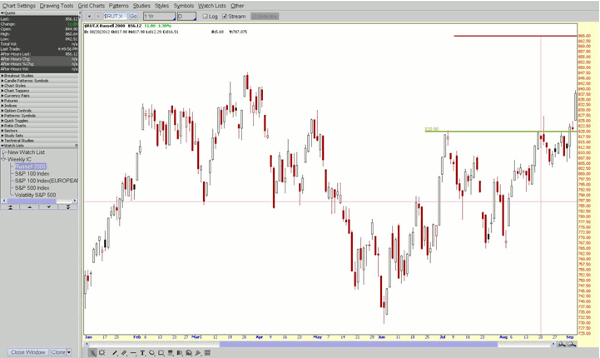Josip Causic of Online Trading Academy reveals some of the possible options a trader has once one short side of an Iron Condor is exited after buying back that obligation.
Original Position: Basically, the short Iron Condor has the expectation that the underlying will stay within a given range. The Bear Call spread carries a margin, as well as the Bull Put spread, both of them being short verticals.
The logic is that the trade cannot be wrong at both ends at the same time. It is possible to be wrong at different times, if the position was unwound. The specifics of my position on the Russell 2000 are given in the next two figures.
The chart above (Figure 1) shows a red line representing the sold 865 call and a green line being the sold 820 put. The table below lists the current price of the underlying, as well as the respective premiums received from the sale of this specific Iron Condor position.
There were 12 contracts and each spread was five points wide. Therefore, the first day margin was ($500×12) $6,000. The next day, the credit of 1.07 per share reduced the margin to ($393×12) $4,716. The exiting orders BTC (Buy to Close) for a nickel were placed.
Next: They were not filled until the last trading session of the RUT...
|pagebreak|They were not filled until the last trading session of the RUT, which is Thursday (September 13). On the same day, Big Ben made the historic and unprecedented announcement of QE3. Consequently the market lifted, and the RUT went with it all the way up to $856.12.
The rally, although strong, never went over the sold 865 call strike price. Within the last hour, the sold 820 puts were repurchased back for a nickel each. However, the margin remained intact on the call side, still at $4,716.
Adjusted Position: Once the short leg contracts are closed on either side of an Iron Condor, the margin will still be intact due to the obligation on the remaining open side.
If the brokerage is progressive, then placing another set of verticals using the same strike difference does not increase the existing margin. Therefore, placing an additional set of short verticals could bring in an additional credit that may go out worthless.
Keep an open mind when trading. Once the short put contracts were closed near the end of the last trading session, then the question became, how could this trade have made even more money from the max profit? Again, thinking outside of the box is required. The answer is by selling the higher 850/845 put spread and receiving additional premium.
The last figure below (Figure 3) shows the attempt to scale in and get a better fill at various prices for the 850/845 Bull Put spread. Each new fill did not affect the increase in margin, which remained constant.
Quite certainly, there are going to be some MoneyShow.com readers who are going to object to such an approach due to the risk. There was the slight possibility that the RUT could gap down because the RUT settles on Friday’s opening print. (By the way, it did not, because the settlement price was $859.62, which was far enough from both sold strikes.)
Keep in mind that this article is about options, which are nothing but multiple possibilities of choices. Each trader ought to decide based on his or her own level of risk tolerance whether opening another trade at the very end of an expiration period even makes sense. (In my case, that was the risk I was willing to take.)
Regardless of a conservative or aggressive decision (such as mine), the choices are there, undeniably. It is only that many traders forget the fact that when trading options, the only limitations are the limitations of one’s mind.
Josip Causic can be found at Online Trading Academy.
























